What is an Earthquake?
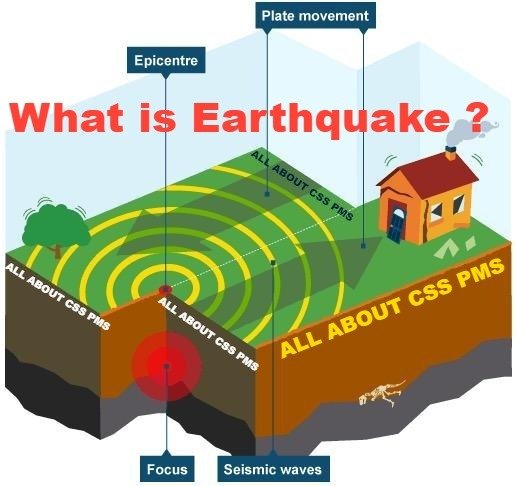
Earthquake :
Earthquakes and volcanoes are examples of sudden movements which originate from inside the earth. Earthquake is the shaking of the earth. An earth quake can be defined as a sudden violent shaking of the ground as a result of movements in the earth's crust or volcanic action. These movements result in the release of energy along a fault and cause the earth to shake. An earthquake, like volcanoes is a type of endogenic processes.
Earthquake ; Important Points:
- The network of seismographic (seismograph is the instrument used to measure earthquakes) stations all over the world record dozens of earthquakes every day. Most of them are not felt by human beings as they are minor quakes only.
- The occurrence of a severe earthquake is limited to a few regions in the world.
- The point within the earth's crust where an earthquake originates is called as the focus or hypocenter or seismic focus.
- It generally lies within a depth of 6 kms in he earth crust.
- The point vertically above the focus on the earth's surface is called as the epicenter.
- The intensity of earthquake will be highest in the epicenter and decreases as one moves away.
- All natural earthquakes take place in the lithosphere (i.e, the region which constitutes the earth's crust and rigid upper part of the mantle).
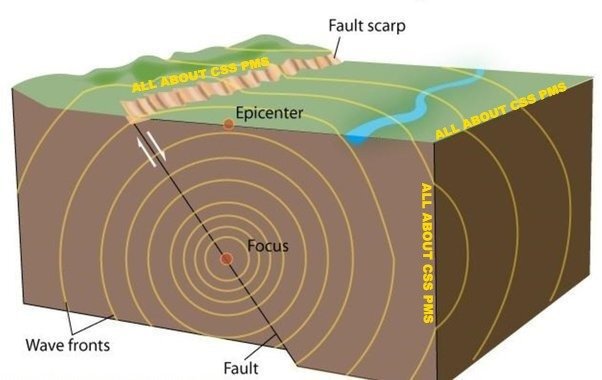
Earthquake waves or Seismic waves :
The earthquake which originates in the lithosphere propagates different seismic waves or earthquake waves.
Earthquake waves are basically of two types body waves and surface waves.
SEISMIC WAVES
| BODY WAVES | SURFACE WAVES | |||
|---|---|---|---|---|
| primary waves (P-waves) | secondary waves (S-waves) | Love waves (L-waves) | Rayleigh waves (R-waves) | |
Body waves :
- They are generated due to the release of energy at the focus and moves in all directions traveling through the body of the earth. Hence, the name -- body waves.
- They travel only through interior of the earth.
- Body waves are faster than surface waves and hence they are the first to be detected on a seismograph.
- There are two types of body waves as primary waves and secondary waves.
Primary Waves (P-Waves) :
- Primary waves are the fastest body waves (twice the speed of s-waves) and are the first to reach during an earthquake.
- They are similar to sound waves , i.e, they are longitudinal waves, in which particle movement is in the same direction of wave propagation.
- They travel through solid, liquid and gaseous materials.
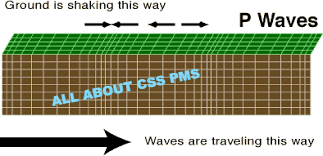
Secondary waves (S-waves) :
- They arrive at the surface with some time-lag after primary waves.
- They are slower than primary waves and can pass only through solid materials.
- This property of s-waves led seismologists to conclude that the earth's outer is in liquid state. (the entire zone beyond 105° from the epicenter does not receive S-waves).
- They are transverse waves in which directions of particle movement and wave propagation are perpendicular to each other.
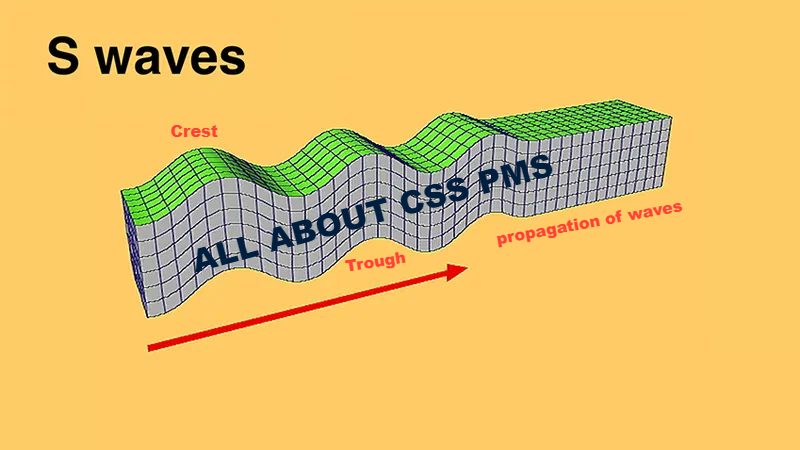
Surface Waves :
When the body waves interact with surface rocks, a new set of waves is generated called as surface waves.
These waves move along the earth surface.
Surface waves are also transverse waves in which particle movement is perpendicular to the wave propagation.
Hence, they create crests and troughs in the material through which they pass.
Surface waves are considered to be the most damaging waves.
Two common surface waves are Love waves and Rayleigh waves.
Love Waves :
- This kind of surface waves causes horizontal shifting of the earth during an earthquake.
- They have much slower than body waves but are faster than Rayleigh.
- They exist only in the presence of semi-infinite medium overlain by an upper finite thickness.
- Confined to the surface of the crust, Love waves produce entirely horizontal motion.
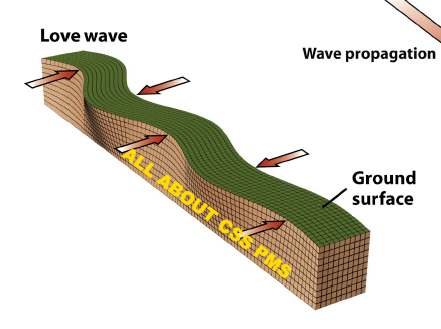
Rayleigh waves :
- These waves follow an elliptical motion.
- A Rayleigh wave rolls along the ground just like a wave rolls across a lake or an ocean.
- Because of rolls, it moves the ground up and down and side-to-side in the same direction that the wave is moving.
- Most of the shaking felt from an earthquake is due to the Rayleigh wave, which can be much larger than the other waves.
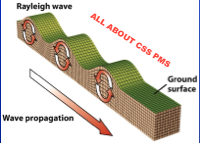
Shadow Regions of Waves :
- P-waves pass through all medium while S-waves passes only through solid medium.
- With the help of these properties of primary waves, seismologists have a fair idea about the interior of the earth.
- Even though P-waves pass through all mediums, it causes reflection when it enters from one medium to another.
- The variations in the direction of waves are inferred with the help of their record on seismographs.
- The area where the seismograph records no waves is called as 'shadow zone' of that wave.
- Accordingly, it is observed that the area beyond 105° does not receive S-waves and the area in between 105° to 140° does not receive P-waves.
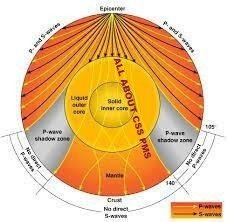
Measuring Earthquakes :
Seismometers are the instruments which are used to measure the motion of the ground, which including those of seismic waves generated by earthquakes, volcanic eruptions, and other seismic sources.
A Seismograph is also another term used to mean seismometer through it is more applicable to the older instruments.
The recorded geographical output from a seismometer/seismograph is called as a seismogram.
Seismograph is an instrument while Seismogram is the recorded output.
Mercalli Scale :
The scale represents the intensity of earthquake by analyzing the after effects like how many people felt it, how much destruction occurred etc. The range of intensity is from 1-12.
Richter Scale :
The scale represents the magnitude of the earthquake. The magnitude is expressed in absolute numbers from 1-10. Each whole number increase in Richter scale represents a ten times increase in power of an earthquake.
Distribution of Earthquakes :
There are two well-defined belts where earthquakes frequently occur --
- The Circum-Pacific Belt
- The Mid-World Mountain Belt.
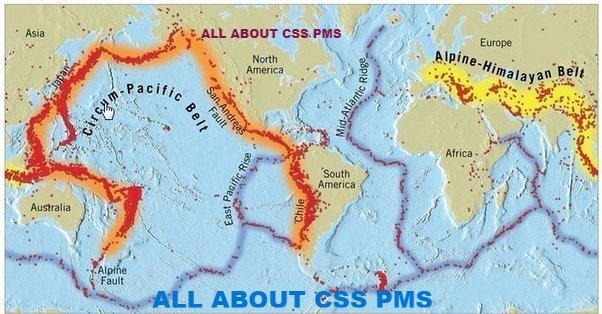
- About 68% of earthquakes in the world occur in the Circum-Pacific Belt.
- Mid -World belt extends from the Alps with their extension into Mediterranean, the Caucasus, and the Himalayan region and continues to Indonesia.
- 21% of earthquakes are occurring in this belt.
- The remaining 11% occur in the other parts of the world.
Terms Associated with Earthquakes :
Focus :
The place of origin of an earthquake inside the earth.
Epicenter :
- Point on the earth's surface vertically above the focus.
- Maximum damage is caused at the epicenter.
Wave Velocity :
5 to 8 km per second through the outer part of the crust but travel faster with depth.
Isoseismic Line :
A line connecting all points on the surface of the earth where the intensity is the same.
Human Induced Earthquakes :
Some earthquakes are human induced.
Earthquakes in the reservoir region, mining sites etc. are human induced.
Some Earthquake inducing human activities :
- Deep mining.
- Underground nuclear tests.
- Reservoir induced seismicity (RIS).
- Extraction of fossil fuels.
- Groundwater extraction.
- Artificial induction.
- In fluid injection, the slip is thought to be induced by premature release of elastic strain, as in he case of tectonic earthquakes, after fault surfaces are lubricated by the liquid.
Effects of Earthquakes :
- Earthquakes cause landslides, damming of rivers, depressions which form lakes.
- They can cause submergence and emergence of landforms along coastal regions. Example : Coastline of Kutch.
- Lead to surface drainage and underground circulation of water.
- More devastating features of earthquakes are fires and seismic waves (tsunamis).
- Formation of cracks or fissures especially in the region of the epicenter is common.
Types of Earthquakes :
- Tectonic Earthquake
- Explosion Earthquake
- Collapse Earthquake
- Volcanic Earthquake
Tectonic Earthquake :
The most common form of earthquake, is caused by the movement of loose fragmented pieces of land on the earth's crust known as tectonic plates.
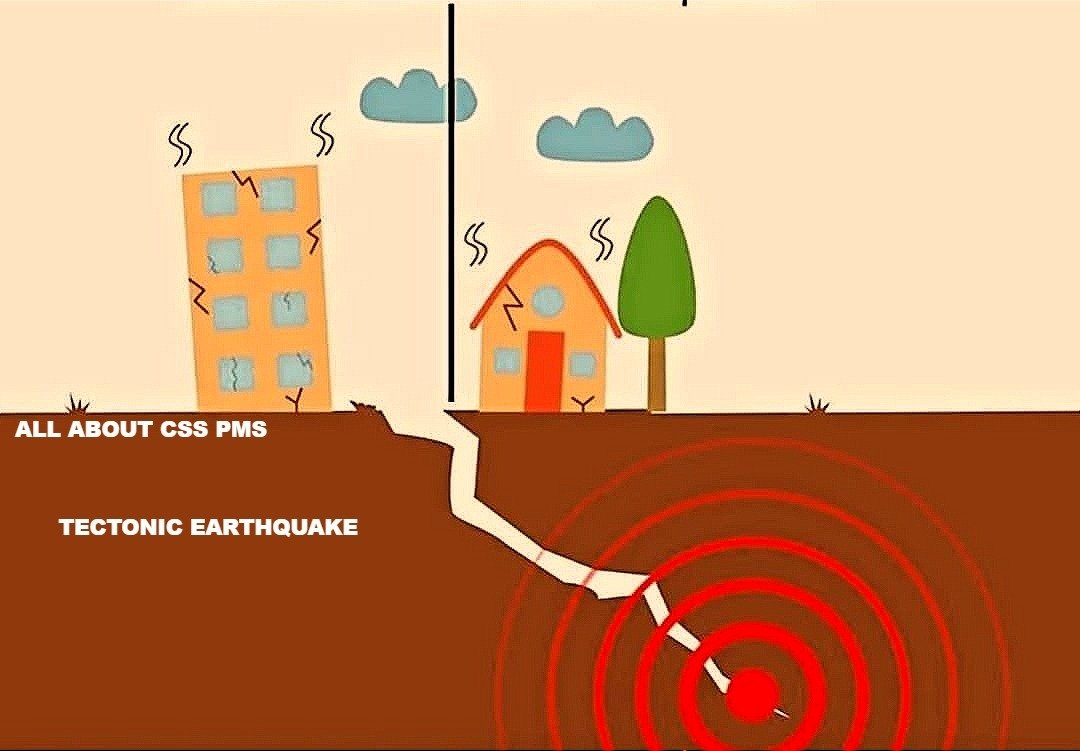
Explosion Earthquake :
The occurrence of this type of earthquake is artificial. High-density explosion such as nuclear explosions is the primary cause.
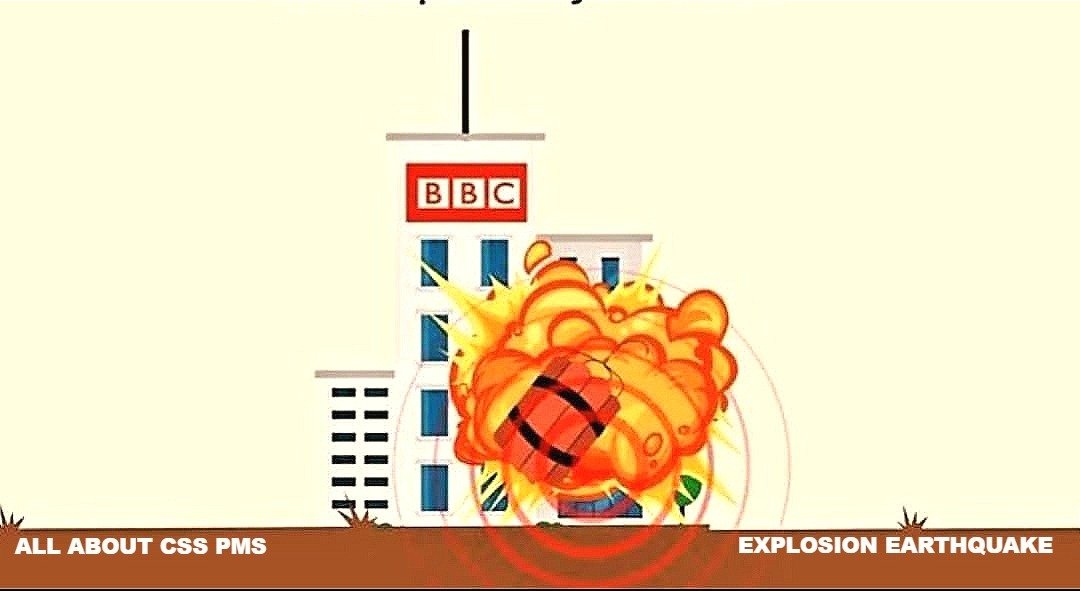
Collapse Earthquake :
This earthquake occurs in underground mines. The main cause is the pressure generated within the rocks.
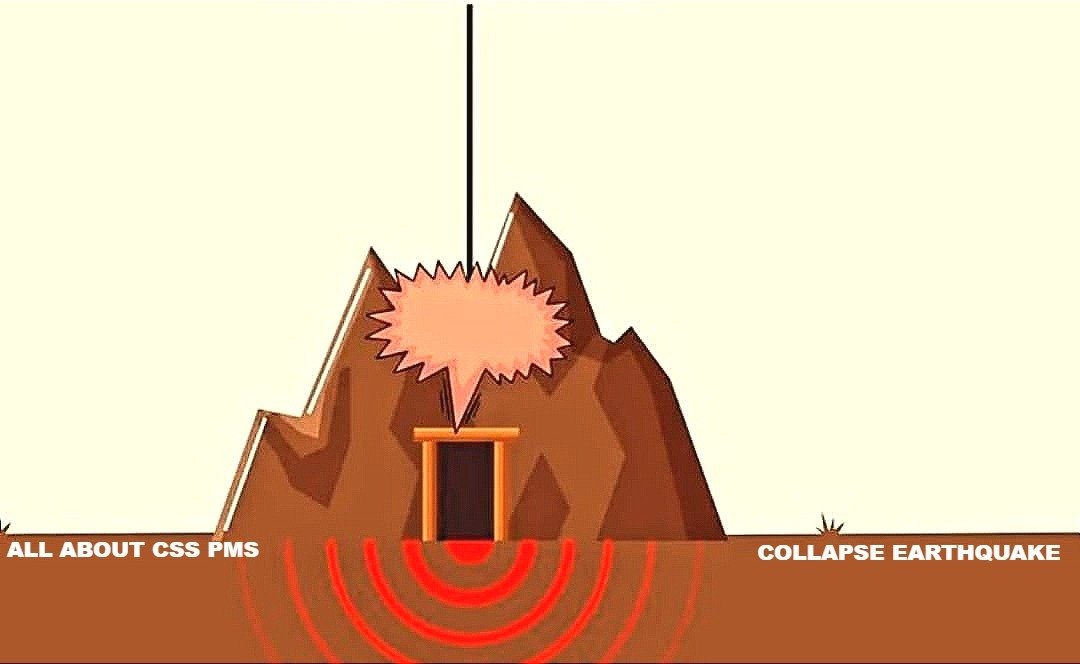
Volcanic Earthquake :
The less prevalent compared to the tectonic variety, these earthquakes happen before or after the eruption of a volcano.
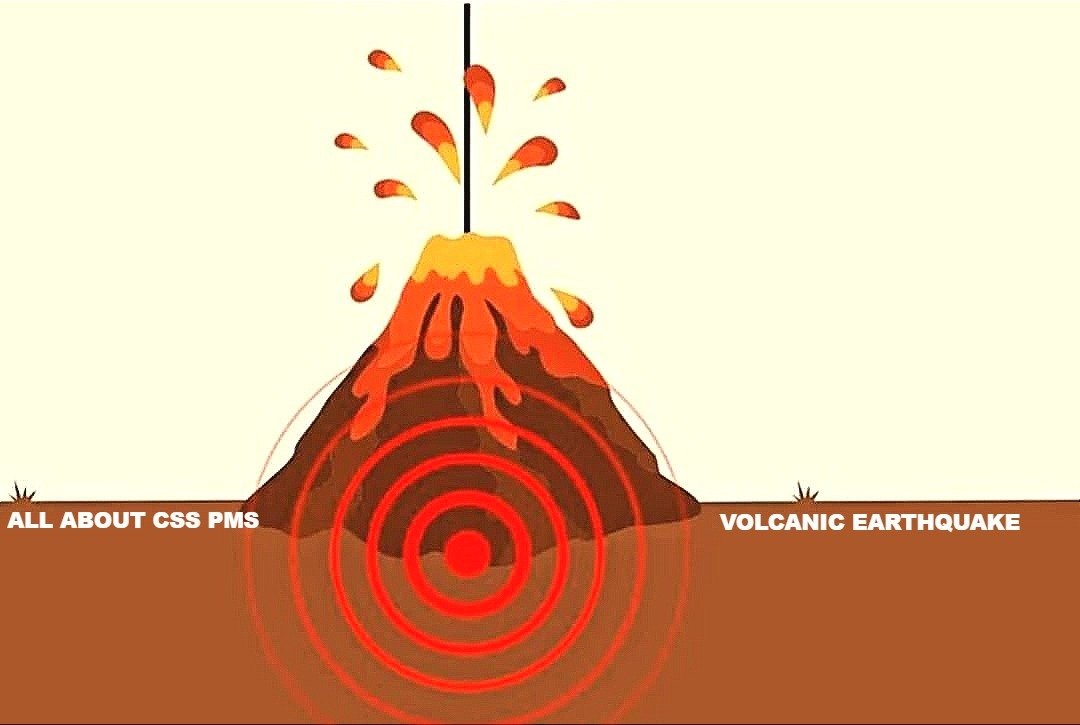
What was the Intensity of the Earthquake in Pakistan dated 26 October 2015 ?
On October 26,2015 at 1409 Hrs. PST and earthquake with 8.1 magnitude stuck Pakistan. It had a depth of 193 Km , centered 82 km Southeast of Faizabad, Afghanistan in he Hindu Kush Mountain Range and lasted up to one minute, mostly areas of Khyber Pakhtunkhwa, Azad Jammu and Kashmir, Gilgit Baltistan and FATA. In terms of magnitude, It was the highest recorded earthquake in the history of Pakistan, however no large scale damages occurred owing to depth of Earthquake. The earthquake was also felt in other Asian Countries including Afghanistan, Iran , China and India.


